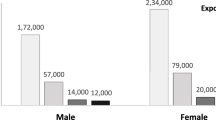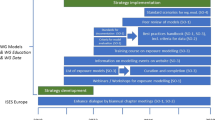Abstract
The aim of this study was to estimate average occupational exposure to inhalable nickel (Ni) using the German exposure database MEGA. This database contains 8052 personal measurements of Ni collected between 1990 and 2009 in adjunct with information on the measurement and workplace conditions. The median of all Ni concentrations was 9 μg/m3 and the 95th percentile was 460 μg/m3. We predicted geometric means (GMs) for welders and other occupations centered to 1999. Exposure to Ni in welders is strongly influenced by the welding process applied and the Ni content of the used welding materials. Welding with consumable electrodes of high Ni content (>30%) was associated with 10-fold higher concentrations compared with those with a low content (<5%). The highest exposure levels (GMs ≥20 μg/m3) were observed in gas metal and shielded metal arc welders using welding materials with high Ni content, in metal sprayers, grinders and forging-press operators, and in the manufacture of batteries and accumulators. The exposure profiles are useful for exposure assessment in epidemiologic studies as well as in industrial hygiene. Therefore, we recommend to collect additional exposure-specific information in addition to the job title in community-based studies when estimating the health risks of Ni exposure.
This is a preview of subscription content, access via your institution
Access options
Subscribe to this journal
Receive 6 print issues and online access
$259.00 per year
only $43.17 per issue
Buy this article
- Purchase on Springer Link
- Instant access to full article PDF
Prices may be subject to local taxes which are calculated during checkout

Similar content being viewed by others
References
IARC. Chromium, Nickel and Welding. IARC Monogr Eval Carcinog Risks Hum. Vol 49. Lyon, France, 1990.
IARC. Cadmium, Nickel, Some Epoxides, Miscellaneous Industrial Chemicals and General Considerations on Volatile Anaesthetics. IARC Monogr Eval Carcinog Risks Hum. Vol. 11. Lyon, France, 1976.
Nickel Institute 2016. Available from http://www.nickelinstitute.org/NickelUseInSociety/AboutNickel/HowNickelIsProduced.aspx. Cited 8 March 2016.
Nickel Institute Safe Use of Nickel in the Workplace: A Guide for Health Maintenance of Workers Exposed to Nickel, its Compounds and Alloys. 3rd edn. Nickel Institute; Nickel Producers Environmental Research Association: Toronto, ON and Durham, NC. 2008.
SCOEL, ed. Recommendation from the Scientific Committee on Occupational Exposure Limits for nickel and inorganic nickel componds [SCOEL/SUM/85]. SCOEL: Brussels, Belgium. 2011.
OSHA Occupational Safety and Health Guideline for Welding Fumes. Occupational Safety and Health Administration. 1997. Available from http://www.osha.gov/SLTC/healthguidelines/weldingfumes/recognition.html. Cited 8 March 2016.
Federal Institute for Occupational Safety and Health TRGS 900 Arbeitsplatzgrenzwerte: German Federal Ministry of Labour and Social Affairs 2006. Available from: URL: http://www.baua.de/nn_16806/de/Themen-von-A-Z/Gefahrstoffe/TRGS/pdf/TRGS-900.pdf. Cited 8 March 2016.
Goldberg M, Goldberg P, Leclerc A, Chastang JF, Marne MJ, Dubourdieu D . A 10-year incidence survey of respiratory cancer and a case-control study within a cohort of nickel mining and refining workers in New Caledonia. Cancer Causes Control 1994; 5: 15–25.
Egedahl R, Carpenter M, Lundell D . Mortality experience among employees at a hydrometallurgical nickel refinery and fertiliser complex in Fort Saskatchewan, Alberta (1954-95). Occup Environ Med 2001; 58: 711–715.
Grimsrud TK, Berge SR, Haldorsen T, Andersen A . Exposure to different forms of nickel and risk of lung cancer. Am J Epidemiol 2002; 156: 1123–1132.
Menvielle G, Luce D, Fevotte J, Bugel I, Salomon C, Goldberg P et al. Occupational exposures and lung cancer in New Caledonia. Occup Environ Med 2003; 60: 584–589.
Gerin M, Fletcher AC, Gray C, Winkelmann R, Boffetta P, Simonato L . Development and use of a welding process exposure matrix in a historical prospective study of lung cancer risk in European welders. Int J Epidemiol 1993; 22 (Suppl 2): 22–28.
OSHA. Occupational exposure to hexavalent chromium. Final Rule. Federal Register 2006; 71: 10099–10385.
Peters S, Vermeulen R, Olsson A, van Gelder R, Kendzia B, Vincent R et al. Development of an exposure measurement database on five lung carcinogens (ExpoSYN) for quantitative retrospective occupational exposure assessment. Ann Occup Hyg 2012; 56: 70–79.
Gabriel S, Koppisch D, Range D . The MGU - a monitoring system for the collection and documentation of valid workplace exposure data. Gefahrstoffe Reinhalt Luft 2010; 70: 43–49.
Stamm R MEGA-database: one million data since 1972Appl Occup Environ Hyg 2001; 16: 159–163.
CEN Workplace Atmospheres, Size Fraction Definitions for Measurement of Airborne Particels: European Standard EN 481. European Committee for Standardization: Brussels, Belgium. 1993.
DFG, ed. Probenahme und Bestimmung von Aerosolen und deren Inhaltsstoffen: Air Monitoring Methods in German Language, 2005 Volume 1. Wiley-VCH Verlag GmbH & Co. KgaA: Weinheim, Germany. 2002.
Bundesanstalt für Arbeit Klassifizierung der Berufe: Systematisches und alphabetisches Verzeichnis der Berufsbenennungen. Bundesanstalt für Arbeit: Nürnberg, Germany. 1988.
Pesch B, Kendzia B, Hauptmann K, van Gelder R, Stamm R, Hahn J et al. Airborne exposure to inhalable hexavalent chromium in welders and other occupations: estimates from the German MEGA database. Int J Hyg Environ Health 2015; 218: 500–506.
Lotz A, Kendzia B, Gawrych K, Lehnert M, Brüning T, Pesch B . Statistical methods for the analysis of left-censored variables. GMS Med Inform Biom Epidemiol 2013; 9.
Harel O . The estimation of R2 and adjusted R2 in incomplete data sets using multiple imputation. J App Stat 2009; 36: 1109–1118.
Loomis D, Kromhout H . Exposure variability: concepts and applications in occupational epidemiology. Am J Ind Med 2004; 45: 113–122.
Pahwa M, Demers P, Ge C . Occupational Exposure Limits for Carcinogens in Ontario Workplaces: Opportunities to Prevent and Control Exposure: Occupational Cancer Research Centre 2012. Available from http://www.occupationalcancer.ca/2012/ocrc-report-occupational-exposure-limits-for-carcinogens-in-ontario-workplaces-opportunities-to-prevent-and-control-exposure/. Cited: 13 October 2016.
Peters S, Vermeulen R, Portengen L, Olsson A, Kendzia B, Vincent R et al. SYN-JEM: a quantitative job-exposure matrix for five lung carcinogens. Ann Occup Hyg 2016; 60: 795–811.
Weiss T, Pesch B, Lotz A, Gutwinski E, van Gelder R, Punkenburg E et al. Levels and predictors of airborne and internal exposure to chromium and nickel among welders—results of the WELDOX study. Int J Hyg Environ Health 2013; 216: 175–183.
Lehnert M, Weiss T, Pesch B, Lotz A, Zilch-Schöneweis S, Heinze E et al. Reduction in welding fume and metal exposure of stainless steel welders: an example from the WELDOX study. Int Arch Occup Environ Health 2013; 87: 483–492.
Jöckel KH, Ahrens W, Pohlabeln H, Bolm-Audorff U, Muller KM . Lung cancer risk and welding: results from a case-control study in Germany. Am J Ind Med 1998; 33: 313–320.
Lavoue J, Friesen MC, Burstyn I . Workplace measurements by the US Occupational Safety and Health Administration since 1979: descriptive analysis and potential uses for exposure assessment. Ann Occup Hyg 2013; 57: 77–97.
Antonini JM, Santamaria AB, Jenkins NT, Albini E, Lucchini R . Fate of manganese associated with the inhalation of welding fumes: potential neurological effects. Neurotoxicology 2006; 27 (3): 304–310.
Author information
Authors and Affiliations
Corresponding author
Ethics declarations
Competing interests
The authors declare no conflict of interest.
Rights and permissions
About this article
Cite this article
Kendzia, B., Pesch, B., Koppisch, D. et al. Modelling of occupational exposure to inhalable nickel compounds. J Expo Sci Environ Epidemiol 27, 427–433 (2017). https://doi.org/10.1038/jes.2016.80
Received:
Accepted:
Published:
Issue Date:
DOI: https://doi.org/10.1038/jes.2016.80
This article is cited by
-
Occupational disease claims and non-occupational morbidity in a prospective cohort observation of nickel electrolysis workers
Scientific Reports (2022)
-
Novel magnetic nanoparticles as adsorbent in ultrasound-assisted micro-solid-phase extraction for rapid pre-concentration of some trace heavy metal ions in environmental water samples: desirability function
Chemical Papers (2020)
-
Modification of magnetized MCM-41 by pyridine groups for ultrasonic-assisted dispersive micro-solid-phase extraction of nickel ions
International Journal of Environmental Science and Technology (2019)
-
New Opportunities in Exposure Assessment of Occupational Epidemiology: Use of Measurements to Aid Exposure Reconstruction in Population-Based Studies
Current Environmental Health Reports (2017)



